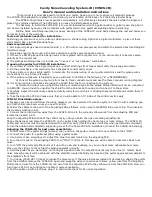
Test Procedures
POTASSIUM
TETRAPHENYLBORON METHOD • CODE 3639-SC
QUANTITY
CONTENTS
CODE
30 mL
* Sodium Hydroxide, 1.0N
*4004WT-G
5 g
* Tetraphenylboron Powder
*6364-C
1
Spoon, 0.05 g, plastic
0696
*WARNING:
Reagents marked with an * are considered to be potential health hazards. To
view or print a Safety Data Sheet (SDS) for these reagents go to www.lamotte.com.
Search for the four digit reagent code number listed on the reagent label, in the contents
list or in the test procedures. Omit any letter that follows or precedes the four digit code
number. For example, if the code is 4450WT-H, search 4450. To obtain a printed copy,
contact LaMotte by email, phone or fax.
Emergency information for all LaMotte reagents is available from Chem-Tel:
(US, 1-800-255-3924) (International, call collect, 813-248-0585).
Potassium, as the seventh most common element on the Earth, may be found in minor
quantities in most water supplies. It seldom exceeds 10 ppm in drinking water and
usually is less than 2 ppm. In some brine or runoff in agricultural areas the potassium
concentration may reach 100 ppm.
APPLICATION:
Drinking, surface, and saline waters.
RANGE:
0.0–10.0 ppm Potassium
MDL:
0.5 ppm
METHOD:
Potassium reacts with sodium tetraphenylborate to form a
colloidal white precipitate in quantities proportional to the
potassium concentration.
SAMPLE HANDLING &
PRESERVATION:
Store samples in polyethylene bottles, not in soft glass where
leaching of potassium from the glass may occur. Samples
may be acidifi ed to pH 2 with nitric acid, but should be
neutralized before analyzing.
INTERFERENCES:
Calcium and magnesium interfere at very high
concentrations. Check for stray light interference (see page
15).
SMART Spectro 2 Test Procedures 05.02.16
POTASSIUM
www.
GlobalScientificSupply
.com
GLOBAL SCIENTIFIC SUPPLY
The Laboratory Supply Company!
















































